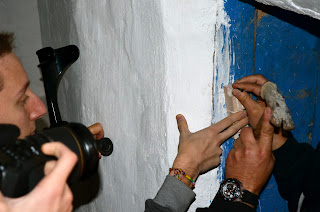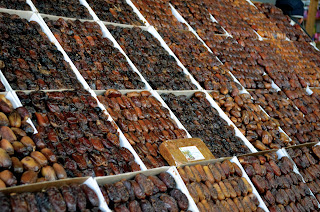Morocco is a country of vivaciously colored buildings, people, and tap water. These vibrant hues reflect the landscape and the unknown substances in the water pipes. Our three days here have seemingly stretched into one bus ride, with a multitude of stops, played on the same continuous Moroccan-Arabic song.
 Following the souk, we ventured to Arazan, a small town (village?) and the site of a shul over 500 years old, known as the Khmiss Arazan Synagogue. Raphy, our Moroccan-Israeli tour guide who dedicated his life to seeking Jewish remnants in rural Morocco, revealed its story:
Following the souk, we ventured to Arazan, a small town (village?) and the site of a shul over 500 years old, known as the Khmiss Arazan Synagogue. Raphy, our Moroccan-Israeli tour guide who dedicated his life to seeking Jewish remnants in rural Morocco, revealed its story:

 Undeniably the Raphy-Harim story remains one of Peter's favorites (see Harim, left, and Peter, right). It has become a token story of Kivunim, a story of the value of the Moroccan Jews in Morocco, a story of fundamental human compassion. Emphasizing the "basic soul and character" Harim so embodies, Peter accentuated Kivunim's obligation to return to Arazan to pay tribute to Harim. Harim also possesses childhood memories of the shul; he remains able to chant part of the Torah service and a Berber-Jewish version of Shalom Aleichem.
Undeniably the Raphy-Harim story remains one of Peter's favorites (see Harim, left, and Peter, right). It has become a token story of Kivunim, a story of the value of the Moroccan Jews in Morocco, a story of fundamental human compassion. Emphasizing the "basic soul and character" Harim so embodies, Peter accentuated Kivunim's obligation to return to Arazan to pay tribute to Harim. Harim also possesses childhood memories of the shul; he remains able to chant part of the Torah service and a Berber-Jewish version of Shalom Aleichem.
Journeying to Errashadiya, we stopped briefly to buy saffron (100 dirham for four grams). Morocco's herbs and spices, so significant to its food culture, supplement my sensory impression of Morocco.
 Until the 1960s, an active Jewish community and its shul existed in the center of Errashadiya. Lack of maintenance and funding depreciated the shul and left it decrepit. Last year, funding from several American Jewish families allowed for renovation. This year, we spent the day painting the shul and reinvigorating it to mint and pistachio green, colors frequented throughout the country. Perhaps Jews (with the exception of Kivunim) may never return to this shul; however, it was powerful to restore a once-vibrant shul to its former glory.
Until the 1960s, an active Jewish community and its shul existed in the center of Errashadiya. Lack of maintenance and funding depreciated the shul and left it decrepit. Last year, funding from several American Jewish families allowed for renovation. This year, we spent the day painting the shul and reinvigorating it to mint and pistachio green, colors frequented throughout the country. Perhaps Jews (with the exception of Kivunim) may never return to this shul; however, it was powerful to restore a once-vibrant shul to its former glory.
Most unfortunately, this same day of revival, a mysterious wave of nausea seized me, only to produce bouts of vomit along the streets of Errashadiya. I have left my mark in more than one way.
 Even undiagnosed digestive dilemmas, however, could not taint my sheer rabab (joy or happiness, also known as my Arabic name) upon visiting the date souk. Who knew of such a thing?
Even undiagnosed digestive dilemmas, however, could not taint my sheer rabab (joy or happiness, also known as my Arabic name) upon visiting the date souk. Who knew of such a thing?
We then ventured to Merzouga via SUVs through the Sahara, accompanied by Moroccan drivers who spoke no English and bore no driving inhibitions. My driver's preferences particularly tested my fragile equilibrium with his sharp turns, aggressive accelerations, and total disregard for large rocks and bushes in our path.
Our hotel Auberge Timbouctou too encompassed the effervescent colors of the country: deep blues and greens in contrast to its adobe outside. Dinner comprised of an array of soups, couscous, and cooked vegetables. By far, however, the warm preserved apricots in a syrup of spices outdid itself.
The next morning, our Saharan dune voyage followed. More to come, so keep a lookout for further tales of the remnants of the Moroccan Jewish experience and of my digestive system.
Rebecca Abbott
(Kivunim - www.kivunim.org) - a gap year before Barnard
Upon arriving the first night after a seven-hour bus ride from Casablanca, we settled outside the medieval city of Taroudant in the Hotel Palais Salaam, a former governor's palace dating back to the 16th century. The richness of the architecture, colors, and gardens compensated for our lack of real food (due to the kosher, vegetarian, no-fresh-produce-in-Morocco diet). The next morning, we visited the souk within the city walls, where Taroudant residents specialize in leather goods. Bargaining proves necessary as sellers often mark up over 60% (though I still managed to buy a leather purse for 100 dirham, or the equivalent of twelve and a half dollars).
 Following the souk, we ventured to Arazan, a small town (village?) and the site of a shul over 500 years old, known as the Khmiss Arazan Synagogue. Raphy, our Moroccan-Israeli tour guide who dedicated his life to seeking Jewish remnants in rural Morocco, revealed its story:
Following the souk, we ventured to Arazan, a small town (village?) and the site of a shul over 500 years old, known as the Khmiss Arazan Synagogue. Raphy, our Moroccan-Israeli tour guide who dedicated his life to seeking Jewish remnants in rural Morocco, revealed its story:
"I had heard of a large Jewish population living in Arazan [prior to their emigration in the 60s]... So I went there. I went to the main street in Arazan, and I walked into a cafe. There were some men sitting there and I walked up to them and began to talk with them...
I said, 'Were there Jews in this village?'
'Yes,' they said to me. But these men had been born after the Jews had left, or they were babies...
'Walk through the Kasbah,' one man encouraged. 'Walk through the Kasbah and find Harim. He knows about the Jews.'
I found Harim, he was about 60. I said to him, 'were there Jews here?' He said yes.
'Was there a synagogue?'
And Harim, a Berber-Muslim man, replied in Hebrew.
'Baruch haba [welcome]. Where have you been? I've been waiting for you.'
Harim pulled out a large, wooden key."

Harim explained that before the rabbi of the community had left, he had approached Harim. "If a Jew comes," the rabbi expressed. "And he asks for the synagogue, bring him this key."
Accepting the key almost 50 years later, Raphy attempted to unlock the shul with some difficulty. Upon asking Harim to open the door, Harim replied that Raphy should open it as "he is the Jew who came." Entering the shul, he recited Shema Yisrael.
 Undeniably the Raphy-Harim story remains one of Peter's favorites (see Harim, left, and Peter, right). It has become a token story of Kivunim, a story of the value of the Moroccan Jews in Morocco, a story of fundamental human compassion. Emphasizing the "basic soul and character" Harim so embodies, Peter accentuated Kivunim's obligation to return to Arazan to pay tribute to Harim. Harim also possesses childhood memories of the shul; he remains able to chant part of the Torah service and a Berber-Jewish version of Shalom Aleichem.
Undeniably the Raphy-Harim story remains one of Peter's favorites (see Harim, left, and Peter, right). It has become a token story of Kivunim, a story of the value of the Moroccan Jews in Morocco, a story of fundamental human compassion. Emphasizing the "basic soul and character" Harim so embodies, Peter accentuated Kivunim's obligation to return to Arazan to pay tribute to Harim. Harim also possesses childhood memories of the shul; he remains able to chant part of the Torah service and a Berber-Jewish version of Shalom Aleichem.
In tribute to Harim, Kivunim raised money to restore the shul. On our day in Arazan, we placed a mezuza in the shul and recited the bracha. Harim, the Berber-Muslim man from the village of Arazan, revisited his boyhood memory and sang Shalom Aleichem.
Journeying to Errashadiya, we stopped briefly to buy saffron (100 dirham for four grams). Morocco's herbs and spices, so significant to its food culture, supplement my sensory impression of Morocco.
 Until the 1960s, an active Jewish community and its shul existed in the center of Errashadiya. Lack of maintenance and funding depreciated the shul and left it decrepit. Last year, funding from several American Jewish families allowed for renovation. This year, we spent the day painting the shul and reinvigorating it to mint and pistachio green, colors frequented throughout the country. Perhaps Jews (with the exception of Kivunim) may never return to this shul; however, it was powerful to restore a once-vibrant shul to its former glory.
Until the 1960s, an active Jewish community and its shul existed in the center of Errashadiya. Lack of maintenance and funding depreciated the shul and left it decrepit. Last year, funding from several American Jewish families allowed for renovation. This year, we spent the day painting the shul and reinvigorating it to mint and pistachio green, colors frequented throughout the country. Perhaps Jews (with the exception of Kivunim) may never return to this shul; however, it was powerful to restore a once-vibrant shul to its former glory.Most unfortunately, this same day of revival, a mysterious wave of nausea seized me, only to produce bouts of vomit along the streets of Errashadiya. I have left my mark in more than one way.
 Even undiagnosed digestive dilemmas, however, could not taint my sheer rabab (joy or happiness, also known as my Arabic name) upon visiting the date souk. Who knew of such a thing?
Even undiagnosed digestive dilemmas, however, could not taint my sheer rabab (joy or happiness, also known as my Arabic name) upon visiting the date souk. Who knew of such a thing?We then ventured to Merzouga via SUVs through the Sahara, accompanied by Moroccan drivers who spoke no English and bore no driving inhibitions. My driver's preferences particularly tested my fragile equilibrium with his sharp turns, aggressive accelerations, and total disregard for large rocks and bushes in our path.
Our hotel Auberge Timbouctou too encompassed the effervescent colors of the country: deep blues and greens in contrast to its adobe outside. Dinner comprised of an array of soups, couscous, and cooked vegetables. By far, however, the warm preserved apricots in a syrup of spices outdid itself.
The next morning, our Saharan dune voyage followed. More to come, so keep a lookout for further tales of the remnants of the Moroccan Jewish experience and of my digestive system.
Rebecca Abbott
(Kivunim - www.kivunim.org) - a gap year before Barnard















